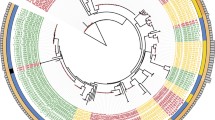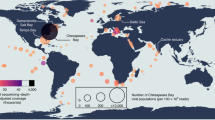Abstract
Investigations of virus–host interactions depend heavily either on their cultivation or on metagenomics. In this study, we combined complementary statistical methods and culture-independent methods to gain deeper insight into virus–host interactions in the Sfax saltern, Tunisia. Samples were collected and the data were statistically evaluated. Hierarchical cluster analysis classified the ponds into two main groups with a sharp cutoff: type A with a salinity value < 24% and type B with salinity > 24%. Redundancy analysis demonstrated a strong correlation between viral abundance, virus-to-prokaryote ratio, and archaea in type B ponds. Head-tailed viruses with medium–small genome size were often predicted to preferentially infect the most abundant hosts in high-salinity ponds, Salinibacter and Haloquadratum, which are both strongly correlated with high Mg2+ concentrations. Based on the redundancy analysis, type A ponds were defined by relatively high Ca2+ content and were dominated by spherical viruses, with the largest genomes infecting either the potential bacterial host Halopeptonella or the archaeal host Halogeometricum. Interestingly, the low-salinity pond M1Oct09 displayed a special viral community pattern. The receiver operating characteristic curve clarified the criteria that could not discriminate between pond types A and B, including Na+, pH, and bacterial abundance. Parameters including the viral and archaeal diversity index and the virus morphotype showed a correlation with salinity but could not be used to discriminate between these types. Combining the complementary statistical and culture-independent methods could serve as suitable evaluation tools for providing clear and easily understandable information on virus–host interactions.







Similar content being viewed by others
References
Antón J, Oren A, Benlloch S, Rodríguez-Valera F, Amann R, Rossello-Mora R (2002) Salinibacterruber gen. nov., sp. nov., a novel, extremely halophilic member of the Bacteria from saltern crystallizer ponds. Int J Syst Evol Microbiol 52:485–491. https://doi.org/10.1099/00207713-52-2-485
Antón J, Peña A, Santos F et al (2008) Distribution, abundance and diversity of the extremely halophilic bacterium Salinibacter ruber. Saline Syst 4:15. https://doi.org/10.1186/1746-1448-4-15
Atanasova NS, Roine E, Oren A, Bamford DH, Oksanen HM (2012) Global network of specific virus–host interactions in hypersaline environments. Environ Microbiol 14:426–440. https://doi.org/10.1111/j.1462-2920.2011.02603.x
Atanasova NS, Oksanen HM, Bamford DH (2015a) Haloviruses of archaea, bacteria, and eukaryotes. Curr Opin Microbiol 25:40–48. https://doi.org/10.1016/j.mib.2015.04.001
Atanasova NS, Bamford DH, Oksanen HM (2015b) Haloarchaeal virus morphotypes. Biochimie 118:333–343
Baxter BK, Mangalea MR, Willcox S, Sabet S, Nagoulat M-N, Griffith JD (2011) Haloviruses of Great Salt Lake: a model for understanding viral diversity. In: Ventosa A, Oren A, Ma Y (eds) Halophiles and hypersaline environments: current research and future trends. Springer, Berlin, pp 173–190
Bettarel Y, Bouvier T, Bouvier C, Carré C, Desnues A, Domaizon I, Jacquet S, Robin A, Sime-Ngando T (2011) Ecological traits of planktonic viruses and prokaryotes along a full-salinity gradient. FEMS Microbiol Ecol 76:360–372. https://doi.org/10.1111/j.1574-6941.2011.01054.x
Bodor A, Bounedjoum N, Vincze GE, Kis ÁE, Laczi K et al (2020) Challenges of unculturable bacteria: environmental perspectives. Rev Environ Sci Biotechnol 19:1–22. https://doi.org/10.1007/s11157-020-09522-4
Bolhuis H, Palm P, Wende A et al (2006) The genome of the square archaeon Haloquadratum walsbyi: life at the limits of water activity. BMC Genom 7:169. https://doi.org/10.1186/1471-2164-7-169
Boujelben I, Gomariz M, Martínez-García M, Santos F, Peña A, López C, Antón J, Maalej S (2012a) Spatial and seasonal prokaryotic community dynamics in ponds of increasing salinity of Sfax solar saltern in Tunisia. Antonie Van Leeuwenhoek 101:845–857. https://doi.org/10.1007/s10482-012-9701-7
Boujelben I, Yarza P, Almansa C, Villamor J, Maalej S, Antón J, Fernando S (2012b) Virioplankton community structure in Tunisian solar salterns. Appl Environ Microbiol 78:7429–7437. https://doi.org/10.1128/AEM.01793-12
Burns DG, Camakaris HM, Janssen PH, Dyall-Smith ML (2004) Cultivation of Walsby’s square haloarchaeon. FEMS Microbiol Lett 238:469–473. https://doi.org/10.1111/j.1574-6968.2004.tb09790.x
Caraux G, Pinloche S (2005) PermutMatrix: a graphical environment to arrange gene expression profiles in optimal linear order. Bioinformatics 21:1280–1281. https://doi.org/10.1093/bioinformatics/bti141
Casamayor EO, Massana R, Benlloch S, Øvreås L, Díez B et al (2002) Changes in archaeal, bacterial and eukaryal assemblages along a salinity gradient by comparison of genetic fingerprinting methods in a multi-pond solar saltern. Environ Microbiol 4:338–348. https://doi.org/10.1046/j.1462-2920.2002.00297.x
Di Meglio L, Santos F, Gomariz M, Almansa C, López C, Antón J, Nercessian D (2016) Seasonal dynamics of extremely halophilic microbial communities in three Argentinian salterns. FEMS Microbiol Ecol 92:fiw184. https://doi.org/10.1093/femsec/fiw184
Díez B, Antón J, Guixa-Boixareu N, Pedrós-Alió C, Rodríguez-Valera F (2000) Pulsed-field gel electrophoresis analysis of virus assemblages present in a hypersaline environment. Internal Microbiol 3:159–164
Dyall-Smith ML, Burns DG, Camakaris HM, Janssen PH, Russ BE, Porter K (2005) Haloviruses and their hosts. In: Gunde-Cimerman N, Oren A, Plamenitaš A (eds) Adaptation to life at high salt concentrations in Archaea, Bacteria, and Eukarya. Springer, Dordrecht, pp 553–564
Elloumi J, Guermazi W, Ayadi H, Bouain A, Aleya L (2009) Abundance and biomass of prokaryotic and eukaryotic microorganisms coupled with environmental factors in an arid multi-pond solar saltern (Sfax, Tunisia). J Mar Biol Assoc UK 89:243–253. https://doi.org/10.1017/S0025315408002269
Ghai R, Pašić L, Fernández AB et al (2011) New abundant microbial groups in aquatic hypersaline environments. Sci Rep 1:135. https://doi.org/10.1038/srep00135
Gomariz M, Martinez-Garcia M, Santos F, Rodriguez F, Capella-Gutierrez S et al (2015) From community approaches to single-cell genomics: the discovery of ubiquitous hyperhalophilic Bacteroidetes generalists. ISME J 9:16–31. https://doi.org/10.1038/ismej.2014.95
Guixa-Boixareu N, Calderón-Paz JI, Heldal M, Bratbak G, Pedrós-Alió C (1996) Viral lysis and bacterivory as prokaryotic loss factors along a salinity gradient. Aquat Microb Ecol 11:215–227. https://doi.org/10.3354/ame011215
Hammer Ø, Harper DAT, Ryan PD (2001) PAST: Paleontological Statistics Software Package for education and data analysis. Palaeontol Electron 4:1–9. http://palaeo-electronica.org/2001_1/past/issue1_01.htm
Jiang S, Steward GF, Jellison R, Chu W, Choi S (2004) Abundance, distribution, and diversity of viruses in alkaline, hypersaline Mono Lake, California. Microb Ecol 47:9–17. https://doi.org/10.1007/s00248-003-1023-x
Johnson RA, Wichern DW (2007) Applied multivariate statistical analysis. Pearson Prentice Hall, Upper Saddle River
Kukkaro P, Bamford DH (2009) Virus–host interactions in environments with a wide range of ionic strengths. Environ Microbiol Rep 1:71–77. https://doi.org/10.1111/j.1758-2229.2008.00007.x
Legault BA, López-López A, Alba-Casado JC, Doolittle WF, Bolhuis H, Rodríguez-Valera F, Papke RT (2006) Environmental genomics of “Haloquadratum walsbyi” in a saltern crystallizer indicates a large pool of accessory genes in an otherwise coherent species. BMC Genomics 7:171. https://doi.org/10.1186/1471-2164-7-171
Lepš J, Šmilauer P (2003) Multivariate analysis of ecological data using CANOCO. Cambridge University Press, Cambridge
Luk AWS, Williams TJ, Erdmann S, Papke RT, Cavicchioli R (2014) Viruses of Haloarchaea. Life 4:681–715. https://doi.org/10.3390/life4040681
Ma Y, Galinski EA, Grant WD, Oren A, Ventosa A (2010) Halophiles 2010: life in saline environments. Appl Environ Microbiol 76:6971–6981. https://doi.org/10.1128/AEM.01868-10
Martínez-García M, Santos F, Moreno-Paz M et al (2014) Unveiling viral-host interactions within the ‘microbial dark matter.’ Nat Commun 5:4542. https://doi.org/10.1038/ncomms5542
McGenity TJ, Oren A (2012) Hypersaline environments. In: Bell EM (ed) Life at extremes: environments, organisms and strategies for survival. CAB International, Wallingford, pp 402–437
Menes RJ, Viera CE, Farias ME, Seufferheld MJ (2015) Halopeptonella vilamensis gen. nov, sp. nov., a halophilic strictly aerobic bacterium of the family Ectothiorhodospiraceae. Extremophiles 20:19–25. https://doi.org/10.1007/s00792-015-0793-7
Metz CE (1978) Basic principles of ROC analysis. Semin Nucl Med 8:283–298. https://doi.org/10.1016/S0001-2998(78)80014-2
Mizuno CM, Prajapati B, Lucas-Staat S, Sime-Ngando T et al (2019) Novel haloarchaeal viruses from Lake Retba infecting Haloferax and Halorubrum species. Environ Microbiol 21:2129–2147. https://doi.org/10.1111/1462-2920.14604
Mutlu MB, Martínez-García M, Santos F, Peña A, Guven K, Antón J (2008) Prokaryotic diversity in Tuz Lake, a hypersaline environment in Inland Turkey. FEMS Microbiol Ecol 65:474–483. https://doi.org/10.1111/j.1574-6941.2008.00510.x
Narasingarao P, Podell S, Ugalde JA, Brochier-armanet C, Emerson JB, Brocks JJ et al (2012) De novo metagenomic assembly reveals abundant novel major lineage of Archaea in hypersaline microbial communities. ISME J 6:81–93. https://doi.org/10.1038/ismej.2011.78
Oh D, Porter K, Russ B, Burns D, Dyall-Smith M (2010) Diversity of Haloquadratum and other haloarchaea in three, geographically distant, Australian saltern crystallizer ponds. Extremophiles 14:161–169. https://doi.org/10.1007/s00792-009-0295-6
Oren A (2011) The halophilic world of Lourens Baas Becking. In: Ventosa A, Oren A, Ma Y (eds) Halophiles and hypersaline environments: current research and future trends. Springer, Berlin, pp 9–25
Oren A (2013) Life in magnesium- and calcium-rich hypersaline environments: salt stress by chaotropic ions. In: Seckbach J, Oren A, Stan-Lotter H (eds) Polyextremophiles. Springer, Dordrecht, pp 215–232
Oren A (2020) The microbiology of red brines. Adv Appl Microbiol 113:57–110. https://doi.org/10.1016/bs.aambs.2020.07.003
Oren A, Bratbak G, Heldal M (1997) Occurrence of virus-like particles in the Dead Sea. Extremophiles 1:143–149. https://doi.org/10.1007/s007920050027
Papke RT, Koening JE, Rodríguez-Valera F, Doolittle WF (2004) Frequent recombination in saltern population of Halorubrum. Science 306:1928–1029. https://doi.org/10.1126/science.1103289
Parikka KJ, Le Romancer M, Wauters N, Jacquet S (2016) Deciphering the virus-to-prokaryote ratio (VPR): insights into virus–host relationships in a variety of ecosystems. Biol Rev 92:1081–1100. https://doi.org/10.1111/brv.12271
Pedrós-Alió C (2005) Diversity of microbial communities: the case of solar salterns. In: Gunde-Cimerman N, Oren A, Plamenitaš A (eds) Adaptation to life at high salt concentrations in Archaea, Bacteria, and Eukarya. Springer, Dordrecht, pp 71–90
Pedrós-Alió C, Calderón-Paz JI, MacLean MH, Medina G, Marrasé C, Gasol JM, Guixa-Boixareu N (2000) The microbial food web along salinity gradients. FEMS Microbiol Ecol 32:143–155. https://doi.org/10.1111/j.1574-6941.2000.tb00708.x
Peña A, Teeling H, Huerta-Cepas J, Santos F, Yarza P, Brito-Echeverría J et al (2010) Fine-scale evolution: genomic, phenotypic and ecological differentiation in two coexisting Salinibacter ruber strains. ISME J 4:882–895. https://doi.org/10.1038/ismej.2010.6
Rodríguez-Valera F, Martín-Cuadrado AB, Rodríguez-Brito B, Pasić L, Thingstad TF, Rohwer F et al (2009) Explaining microbial population genomics through phage predation. Nat Rev Microbiol 7:828–836. https://doi.org/10.1038/nrmicro2235
Roine E, Oksanen HM (2011) Viruses from the hypersaline environment. In: Ventosa A, Oren A, Ma Y (eds) Halophiles and hypersaline environments: current research and future trends. Springer, Berlin, pp 153–172
Sandaa RA (2009) Viruses, environmental. In: Schaechter M (ed) Encyclopedia of microbiology, 3rd edn. Academic Press, Oxford, pp 553–567
Sandaa RA, Skjoldal EF, Bratbak G (2003) Virioplankton community structure along a salinity gradient in a solar saltern. Extremophiles 7:347–351. https://doi.org/10.1007/s00792-003-0328-5
Santos F, Yarza P, Parro V, Meseguer I, Rosselló-Móra R, Antón J (2012) Culture-independent approaches for studying viruses from hypersaline environments. Appl Environ Microbiol 78:1635–1643. https://doi.org/10.1128/AEM.07175-11
Sime-Ngando T, Lucas S, Robin A, Tucker KP, Colombet J, Bettarel Y et al (2011) Diversity of virus–host systems in hypersaline Lake Retba, Senegal. Environ Microbiol 13:1956–1972. https://doi.org/10.1111/j.1462-2920.2010.02323.x
Ventosa A, Fernandez AB, Leon MJ, Sanchez-Porro C, Rodriguez-Valera F (2014) The Santa Pola saltern as a model for studying the microbiota of hypersaline environments. Extremophiles 18:811–824. https://doi.org/10.1007/s00792-014-0681-6
Walsby AE (1980) A square bacterium. Nature (london) 283:69–71
Wei M, Xu K (2020) New insights into the virus-to-prokaryote ratio (VPR) in marine sediments. Front Microbiol 11:1102. https://doi.org/10.3389/fmicb.2020.01102
Winter C, Bouvier T, Weinbauer MG, Thingstad TF (2010) Trade-offs between competition and defense specialist among unicellular planktonic organisms: the “Killing the Winner” hypothesis revisited. Microbiol Mol Biol Rev 74:42–57. https://doi.org/10.1128/MMBR.00034-09
Zhang R, Weinbauer MG, Peduzzi P (2021) Aquatic viruses and climate change. Curr Issues Mol Biol 41:357–380. https://doi.org/10.21775/cimb.041.357
Zweig MH, Campbell G (1993) Receiver-operating characteristic (ROC) plots: a fundamental evaluation tool in clinical medicine. Clin Chem 39:561–577. https://doi.org/10.1093/clinchem/39.4.561
Acknowledgements
We are grateful to the staff of the Sfax saltern. The descriptive analysis of this study was supported by projects from the Spanish Agency for International Cooperation (AECI) and CGL2009-12651-C02-01 from the Spanish Ministry of Science and Innovation (MICINN). The authors would like to thank Mr. Abdelmajid Dammak for his proofreading of the manuscript.
Author information
Authors and Affiliations
Corresponding author
Additional information
Responsible Editor: Mohamed Ksibi.
Supplementary Information
Below is the link to the electronic supplementary material.
Rights and permissions
Springer Nature or its licensor holds exclusive rights to this article under a publishing agreement with the author(s) or other rightsholder(s); author self-archiving of the accepted manuscript version of this article is solely governed by the terms of such publishing agreement and applicable law.
About this article
Cite this article
Boujelben, I., van Pelt, J. & Maalej, S. Combination of statistical methods for easy analysis and classification of virus–host environmental dynamics in the saltern of Sfax, Tunisia. Euro-Mediterr J Environ Integr 7, 463–476 (2022). https://doi.org/10.1007/s41207-022-00323-5
Received:
Accepted:
Published:
Issue Date:
DOI: https://doi.org/10.1007/s41207-022-00323-5




